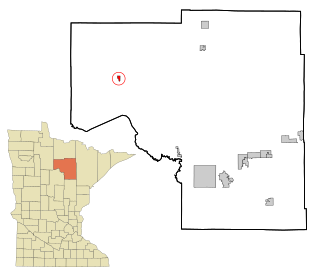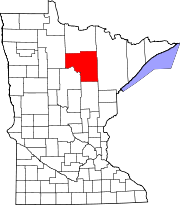
Ramsey is a suburban city 22 miles (35 km) north-northwest of downtown Minneapolis in Anoka County, Minnesota, United States. The population was 27,646 at the 2020 census. It is a northwest suburb of the Twin Cities.
Hornet Township is a township in Beltrami County, Minnesota, United States. The population was 227 as of the 2000 census.
Balsam Township is a township in Itasca County, Minnesota, United States. The population was 550 at the 2010 census.

Bigfork is a city in Itasca County, Minnesota, United States. The population was 446 at the 2010 census. Scenic State Park is nearby.

Calumet is a city in Itasca County, Minnesota, United States. The population was 367 at the 2010 census.

Coleraine is a city in Itasca County, Minnesota, United States. The population was 1,970 at the 2010 census. The community was named after Thomas F. Cole, President of the Oliver Iron Mining Company.
Deer River Township is a township in Itasca County, Minnesota, United States. The population was 704 at the 2010 census.

Effie( EF-ee) is a city in Itasca County, Minnesota, United States. The population was 123 at the 2010 census.

Keewatin is a city in Itasca County, Minnesota, United States. The population was 984 at the 2020 census.
Kinghurst Township is a township in Itasca County, Minnesota, United States. The population was 106 at the 2010 census.

La Prairie is a city in Itasca County, Minnesota, United States. The population was 665 at the 2010 census.
Lone Pine Township is a township in Itasca County, Minnesota, United States. The population was 410 at the 2010 census.

Marble is a city in Itasca County, Minnesota, United States. It is part of the chain of small mining towns known as the Iron Range. The population was 701 at the 2010 census.
Morse Township is a township in Itasca County, Minnesota, United States. The population was 615 at the 2010 census.
Nore Township is a township in Itasca County, Minnesota, United States. The population was 57 at the 2010 census.
Oteneagen Township is a township in Itasca County, Minnesota, United States. The population was 310 at the 2010 census.
Spang Township is a township in Itasca County, Minnesota, United States. The population was 264 at the 2010 census.

Squaw Lake is a city in Itasca County, Minnesota, United States. The population was 107 at the 2010 census.
Stokes Township is a township in Itasca County, Minnesota, United States. The population was 230 at the 2010 census.
Deer Lake is an unorganized territory in Itasca County, Minnesota, United States. The population was 3,495 at the 2010 census.











